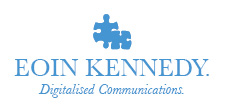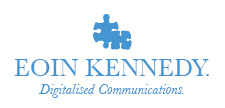Will the Arts lead the Web 2.0 Wave?
The Arts Council ran a thought provoking conference yesterday in Dublin Castle entitled New Media New Audience. The attendees ranged from small theatrical organisations to service providers. It was positioned as a thought platform but the organisation went beyond that to a full scale programme with a variety of different experts. The arts sector has great potential to exploit the benefits and opportunities of online but there was a general initial reluctance due to lack of awareness of the tools, the size and nature of online audiences and concerns about artistic integrity.
Dr. Martin Mansergh TD introduced the conference talking about the boundaries that arts organisations have always worked within and the challenges and opportunities in expanding these to the online world. Theatrical companies have worked within the physical boundaries to date but virtual presences with video casting of performances can extend this to new audiences but care needs to be taken in maintain artistic integrity.
The conference kicked off with a lively and eloquent debate between Charles Leadbeater and Andrew Keen. Both inevitably agreed that communication has changed and the landscape is hugely different but differed huge on the value of the change. Charles Leadbeater argued that change is positive and that we now live in an era of Peddles and Bolders. Bolders being the larger broadcasters such as the BBC and Peddles being the nimble online players from bloggers, online communities and social media sites such as You Tube, Facebook and Flickr. Leadbeater opened up his section with a You Tube video by funtwo which has received over 52 million views to date as an example of how content can be developed without the need for permission, low production values yet reach a huge audience. He then walked through the route that one would have to go through to make it fit with a bolder like the BBC. To him this movement best represents the Bolders/Peddles analogy. The analogy is not static and bolders can utilise peddles and spoke about Obama being a Bolder who did peddles and reach a huge community. Arts organisations need to develop a more user centric view and acknowledge that the role of the artist in challenging the status quo and environment.
In defining the role of new media he spoke about personal example of going to a match being only one part of the experience and blogs and other new media allow him the capability to express views and talk about the experience. Enjoy, Talk and Do helps classify how people engage and the change to the Enjoy being higher with younger audiences.
He finished his section by talking about how his son interacts with technology and how it has changed from his own childhood experiences. From his memories of spending Sundays evenings watching Songs of Praise he recalled how his son recently shocked him by going online one Sunday evening and creating his own animated series from scratch without help.
Andrew Keen has a contradictory view of the value that democratisation of the web has brought and indeed if the web is now more ‘square’ and less democratic.
He questioned how much money has been made by people on You Tube, has it made them any better despite the huge viewership figures and if these experiences has made the arts any richer in terms of integrity and quality of content.
He presented a view that cultural authority is being destroyed by You Tube and that self publishing on the internet is a cultural assault on authority.
He maintained that the personalisation of culture does away with standards and that “Cultural authority” like the BBC are a good and necessary force. He cited his own experience of self publishing where worrying about production etc meant he delivered a poor product and when he used the infrastructure of the BBC he was paid for what he did and the product was better.
There is a crisis in professional media business and that is may be noble to give away your IP for free but it is foolish not to monetising talent.
He maintains he is in favour of internet and acknowledges there is not going back but the monitising question is one of the big issues. He also questioned the distribution power of You Tube who he maintained can only sell advising against 3% of their invertory as the rest in either stolen or inappropriate
He asked the question that if copy is free does creativity because valveless and that physical presence is all that can be exploited. He cited that in the music industry that concerts are the main revenue generation and that this has made the artists less accessible and that the music has become more about marketing than the art itself.
He asked what happens to the shy artist in this environment where marketing becomes everything.
Eoin Purcell chaired a follow on session with a panel looking at New Media in practice where Consistency, Constraint and Quality of content were key themes. Sheila de Courcy from RTE shared her views about what works with younger audience citing games, video, photos, getting a behind the scenes experience and something edgy helping to keep them engaged. Too much text was mentioned as a turn off.
She also spoke about collaborative content they had generated with younger audiences and presented a mock send up of Primetime. One of the attendees questioned the help that was given in generating this content, a view which was shared by Nicky Gogan in the panel that professional help was needed to ensure quality and that scripts were written in collaboration and that without help content was less likely to be developed.
The use of online tools to create art was also discussed in addition to using services such as Amazon to self publishing and monitise the content.
Using online to find peers and create links and foster relationships especially for collabaoration was also discussed.
Over all there was an appreciation of the power of Online for Promotion, despite a nervousness about the quantity of time needs, loosing IP but very little focus on the collaboration potential.
Damien Mulley presented another session on Web 2.0 and New Media where he gave insight into the interests and behaviour of digital natives and online users. In a recent poll almost half a class of third level student reported download programme series rather than watch on TV. This emerging group also use online peers for recommending new shows and trends. In discussing the speed of news dissemination he pointed to live Twitter feeds beating news services who were slow but whose reports contained more detail, if somewhat delayed. A centric world of ‘if news or products are worth knowing then they would make their way to user through their channels’ was also explained.
On a positive side he discussed the power of creating online evangelists.
A flash back to early web experience of Yahoo and searches comprising of directory listings gave a good back drop for the positioning of Web 2-0 being about connecting people while Web 1 was connecting people to web.
Finding out where your audiences are: ie on boards.ie or Bebo was of equal importance to approaching them in the right manner and using similar styles (writing and video).
The power of building a network was supported by the Nike/Apple collaboration where real relationships have been developed with the creation of Super Fans. Feed back on the quality and potential improvement through these networks has resulted in the development of better running shoe and building of online evangelists. Online connections and friends can be fickle and mean a lot less than off line relationships but Damien pointed out that even weak connections can take root and that Familiar Strangers can be converted to friends over time.
A relatively low number of attendees admitted to understanding blogs and the potential of blogs to increase SEO, becoming a recognised expert, improving your message, free R&D and creating interaction were pointed out as reason to utilise this medium. Fear of comments were countered by a note that it is better to have people discuss you on a platform you have access to and that you can change someone who complains about your product to someone who is favourable to your company.
Damien finished by discussing social media and the ability to target very exact groups on Facebook (300,000 Irish users) according to interest areas and demographic details e.g. targeting engaged women with wedding products. He also discussed a Taxi company in Galway who have utilised their 500 friends on the Bebo network (1 million Irish users) and offer discounts for Bebo users.
LinkedIn as a professional social networking platform is one that is underutilised but new services are allowing people to leverage the 20 million audience.
In the research session RTE and AMAS presented some interesting figures on online audiences including that 2% of adults listened to a podcast in last month with over 67,000 downloading the Mairan Finucane interview with Nuala O’Faoilan.
Aileen O’Toole discussed the power of silver surfers and the growth of marketing budgets going on line.
Over all a lot of good sharing of content but some of the most interesting debates were off line which was one of the objectives. One of the final sessions one ‘New Media- Old Audience’ contained some great examples of what the Royal Shakespeare Company are doing. Speaker Mark Ball spoke about putting plays and other catalogue items online something that there was a general reluctance to do amongst the audience. In a Q&A session he spoke about the dual aims of their strategy of creating links with a new audience who will never visit their theatres as well as enhancing the experiences of those going to these plays, something that was echoes by Fiona Kearney, (Director of the Glucksman Gallery).
In a stark example of the difference between digital emigrants and digital natives moderator Stuart McLaughlin (Chief Executive, Business to Arts) spoke about going to plays with his 5 year old son. Before he goes to any play he wants to see some of it online first, then following the play he wants to reenact and upload his version of the play.
Stark new realities on the way communications are rapidly changing and a general message of better to ride the wave, even if uncomfortable, than being swept under.



5 Comments. Leave new
[…] Eoin Kennedy […]
A great piece of writing. Thank you so much. So professionally presented. So thoughtfully laid out. I’ll return to it in order to remind me of the conference. Also, you went to different session from those I went to. So it’s great to have a view on what was going on next door.
Yesterday gave me the resolution to see if I can make twitter work for me. Thanks again.
Superb summary of the day Eoin – and my apologies for the late night mails extolling the virtues of Your Spaces!
[…] control access to musicans and official use of music by brands. This supports the arguement by Andrew Keen that the actual music sales are the minority of the financial earnings for […]
[…] control access to musicans and official use of music by brands. This supports the arguement by Andrew Keen that the actual music sales are the minority of the financial earnings for […]